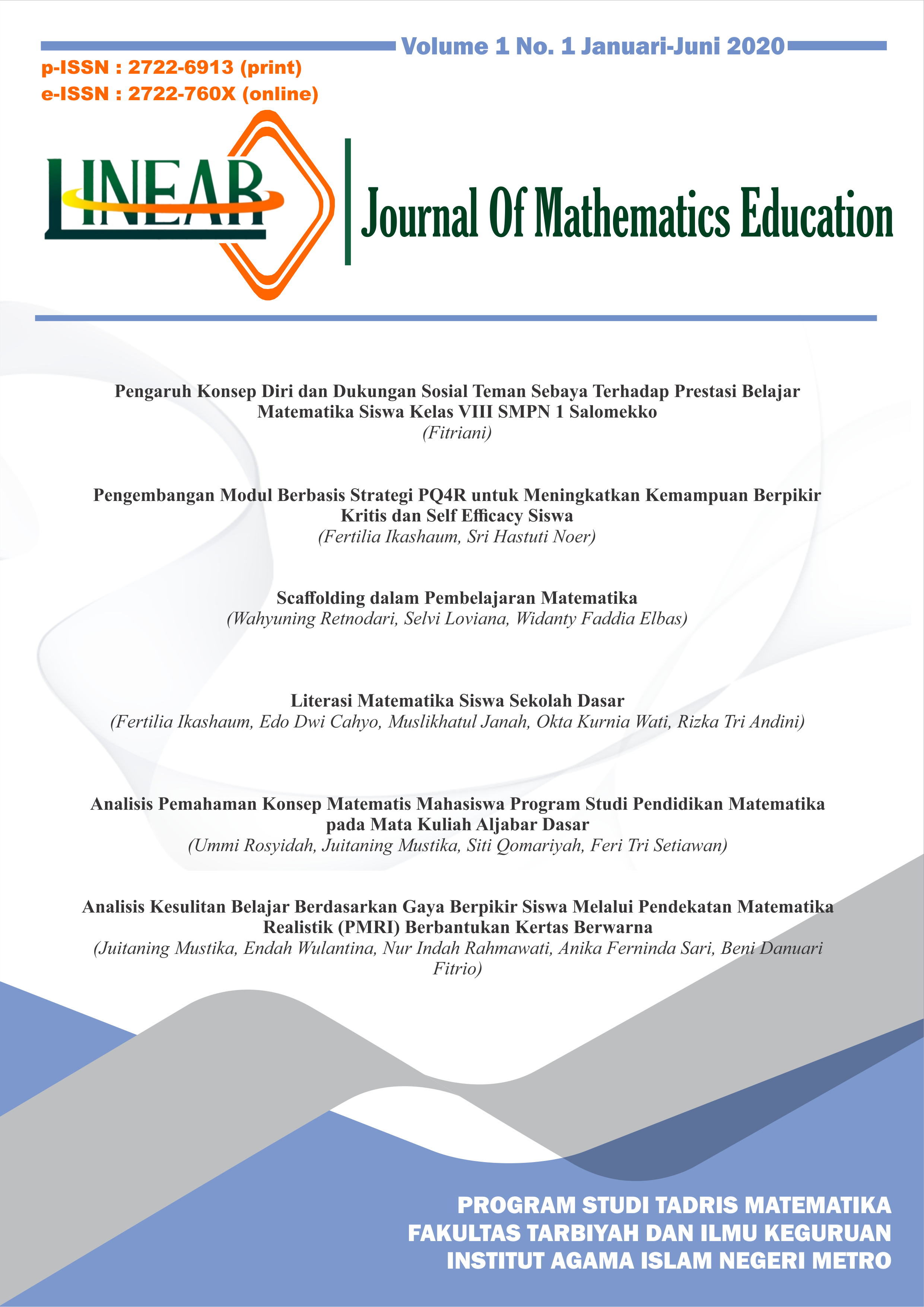ANALISIS KESULITAN BELAJAR BERDASARKAN GAYA BERPIKIR SISWA MELALUI PENDEKATAN MATEMATIKA REALISTIK (PMRI) BERBANTUKAN KERTAS BERWARNA
DOI:
https://doi.org/10.32332/linear.v1i1.2208الكلمات المفتاحية:
Realistic Mathematical Approach, Thinking Style, Colored Paperالملخص
The purpose of this study was to determine student thinking styles in solving mathematical problems in integer count operations material through the Realistic Mathematical Approach (PMRI) assisted by colored paper media. This research method is a qualitative method. Data collection instruments using test, observation and documentation. Learning at the primary school level tends to be textbook oriented and conventional so that it requires student learning innovation that can facilitate mathematics learning. The realistic mathematics approach (PMRI) is one of the innovations that connect student real world with learning mathematics in solving mathematical problems. In the world of education, the characteristics of students' thinking styles in learning are not taken into account, which should be considered in learning. Peaget's development theory states that elementary school students fall into the category of concrete operations stages so that researchers use colored paper media to assist students in understanding the operations of addition and subtraction of integers.
المراجع
Gerlach, V. S. dan D. P. E. (1980). Teaching & Media: A Systematic Approach. Second edition. In (Englewood Cliffs, New Jersey: Pre).
Gregorc, A. F. (1989). Mind Styles. http://web.cortland.edu/andersmd/learning /gregorc.htm
Haji, S. (2005). Pengaruh Pendekatan Matematika Realistik terhadap Matematika di Sekolah Dasar. http://repository.upi.edu/id/eprint/7943
Hasrul. (2009). Pemahaman Tentang Gaya Belajar. Jurnal Medtek, 1(2), 1–9.
Lisdiana, A. (2019). Mematik Ketrampilan Sosial Siswa Melalui Model Pembelajaran Two Stay-Two Stray ( TS-TS ). Tarbawiyah: Jurnal Ilmiah Pendidikan, 03; Nomor (Desember), 162–183. https://doi.org/10.32332/tarbawiyah.v3i2.1779
Marpaung, Y. (2007). Konstruktivisme. Seminar Nasional Pendidikan Matematika di UniversitasNegeri Surabaya, tanggal 8-9 Juni 2007
Marpaung, Y. (2008). Pembelajaran Matematika yang Inovatif. Pelatihan guru-guru SMP di USD, Hotel LPP dan P4TK Matematika Juli 2008.
Moelong, L. J. (2013). Metode Penelitian Kualitatif. bandung: PT. Remaja Rosda Karya
Mustika, J. (2016). Upaya Meningkatkan Aktivitas Dan Hasil Belajar Matematika Menggunakan Model Cooperative Learning Tipe Course Review Horay (CRH). Jurnal E-DuMath, 2(2), 224–232. https://ejournal.stkipmpringsewu-lpg.ac.id/index.php/edumath/article/view/186/129
Mustika, J. (2019). Pengaruh penggunaan Model Pembelajaran Advance Organizer Tipe Expository terhadap Hasil Belajar matematika Siswa Kelas X SMA PGRI Metro. In Jurnal Karya Pendidikan Matematika (Vol. 6, Issue 1). https://doi.org/10.26714/jkpm.6.1.2019.1-7
Qomariyah, S., & Rosyidah, U. (2018). Analisis Aktivitas dan Hasil Belajar Siswa Ditinjau Dari Tipologi Belajar Siswa Kelas VII SMP Negeri 1 Sekampung Udik. JTAM | Jurnal Teori Dan Aplikasi Matematika, 2(1), 96. https://doi.org/10.31764/jtam.v2i1.307
Ruseffendi, E. (2001). Pengantar Kepada Membantu Guru Mengembangkan Kompetensinya dalam Pengajaran Matematika untuk Meningkatkan CBSA. bandung: Tarsito
TIMSS. (1999). International Student of Achievement in Mathematics. The Mathematical Gazette, 55(393), 347. https://doi.org/10.2307/3615061
Triyuwono, A. S. (2009). Perbandingan antara Minat Belajar dan Pemahaman Konsep Matematika Siswa Kelas VII SMP/Mts yang Berasal dari SD/MI Yang Menerapkan PMRI dan SD/MI yang Tidak Menerapkan PMRI. In Tesis. Surakarta: UNS.
Turmudi. (2011). Pengembangan Materi Ajar Matematika Realistik di Sekolah Dasar. Bandung: Tidak Diterbitkan.














